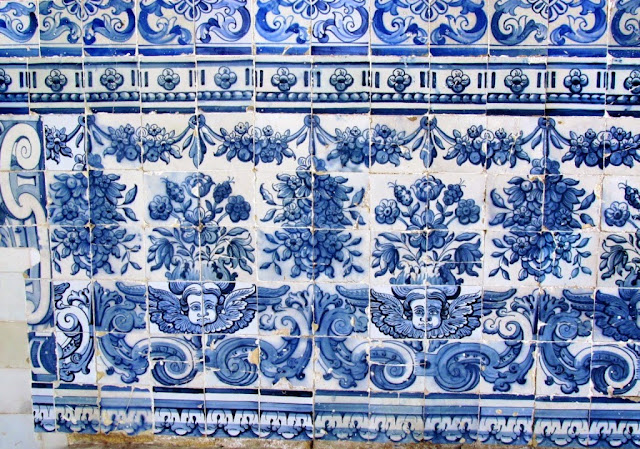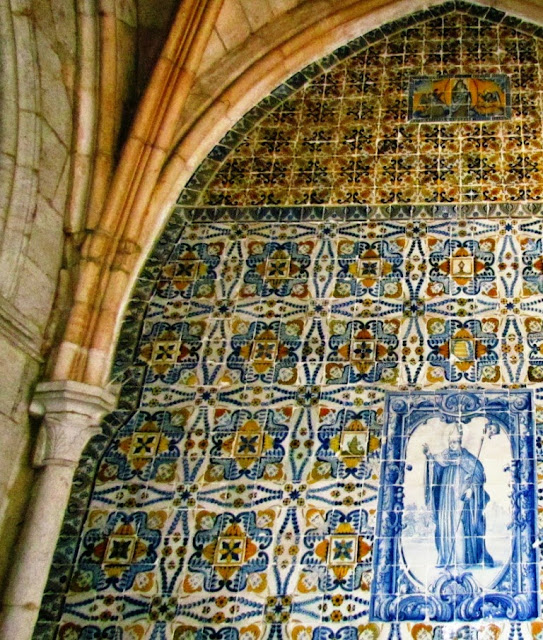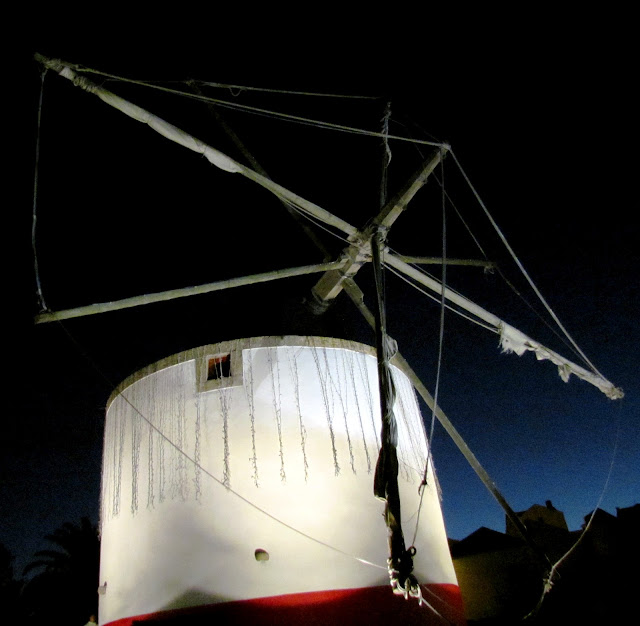ODIVELAS
(P) GPS N38.78604; W9.17339
(P) GPS N38.78604; W9.17339
Odivelas is a city in the district of Lisbon, region, and sub-region of the Metropolitan Area of Lisbon, with around 144 000 inhabitants.
It is the seat of a municipality with an area of 26.54 km² and 144 549 inhabitants (2011), divided since 2013 into 4 parishes.
The municipality is limited to the northeast by the municipality of Loures, to the southeast by Lisbon, and to the west by Amadora and Sintra.
The city started to be connected to Lisbon through the subway network, with the extension of the Yellow Line from Campo Grande, with stations in Senhor Roubado and Odivelas.
In the main square of Odivelas in 1415, Philippa of Lancaster blessed her three sons (Edward, Peter, and Henry) when they departed on horseback for Restelo, where they would begin their overseas voyage to take the city-state of Ceuta.
The theft from the main church of Odivelas (on 11 May 1671) was the origin of the monument dedicated to the Senhor Roubado (English: Stolen Lord), and which would give rise to the first political cartoon, that would criticize the activities of the Inquisition.
The most famous monument in Odivelas is the women's Convent of Saint-Denis of Odivelas, founded by King Dinis I around 1295. Many famous religious women lived in the convent, which was frequently visited by Kings and Queens (indeed, several Kings had illegitimate sons with the nuns). The Gothic convent was very much damaged in the 1755 Lisbon earthquake, but the apse has survived, as well as the tomb of King Dinis and his daughter, Princess Maria Afonso. The Convent also has interesting architecture in Manueline and Baroque styles.
Another interesting sight is the Odivelas Memorial, a curious, early 14th-century monument. It carries a coat-of-arms of Portugal in the late 15th-century style, when the monument may have been restored. The purpose of this monument is not exactly known, but it may have been erected to mark the arrival of the body of King Dinis in Odivelas, to be buried in the Convent.
In the early 18th century, King John V, ordered the construction of an aqueduct to transport water from the parish of Caneças to the city of Lisbon, which suffered from a chronic lack of water. The Águas Livres Aqueduct, which began to operate in 1748, is one of the masterpieces of ancient Portuguese engineering.
 |
| METRO STATION "ODIVELAS" |

ODIVELAS CHURCH
The Odivelas church was rebuilt at the end of the 17th century, with the probable date of its original construction being the year 1573.
It is a Baroque church with a longitudinal plan articulated by the juxtaposition of the nave and the chancel with rectangular shapes, along the narrowest and lowest chancel. It is covered with gable roofs in a coruchéu being the interior space open with round arches where seven altars in gilded carvings and the altarpieces are found, highlighting the main retable, with a high rococo dressing room in gilded carvings. It has a tiled wainscoting, before 1740, that runs through the nave and where biblical figures can be seen. The church also has two red marble rocaille baptismal sinks. The chancel, which dates from the 18th century, is covered in marble of different colors.
The Church was the scene of an assault on May 11, 1671, an action that led to the construction of the pattern of Senhor Roubado.
GPS N38.79136; W9.18149
The Monastery of Saint-Denis (Portuguese: Mosteiro de São Dinis) is located in the city of Odivelas, near Lisbon, in Portugal. The feminine Cistercian convent was founded by King Dinis I and was built during the 14th century in Gothic style. It is the burial place of the king.
The existence of a royal palace in Odivelas meant that the monastery was favored by some Portuguese monarchs during the Middle Ages.
An important figure associated with the monastery is Queen Philippa of Lancaster, who lived some time in the monastery until her death in 1415. The Queen was provisionally buried in the church of the monastery until being translated to the Monastery of Batalha.
In the early 16th century, there were several improvements in the monastery, including the building of a new cloister in Manueline style and a Renaissance gallery by the entrance. In the early 18th century, the monastery was frequently visited by King John V, who had a scandalous affair with Mother Paula (1701-1768), abbess of the monastery. They had an illegitimate son, José, one of the so-called Children of Palhavã.
The Odivelas monastery was greatly damaged by the 1755 Lisbon earthquake, and had to be partially rebuilt. The nave of the church, in particular, was totally remodeled, leaving only the apse and its three chapels in the original 14th-century Gothic style.
The monastery has two cloisters. The main cloister was built in the 14th century, but nowadays only parts of the original vaulting still exist. In the early 16th century the monastery was partially remodeled in Manueline style. The main cloister gained many Manueline portals, and a second cloister, nicknamed the Claustro da Moura was built. Later in the century, a gallery (loggia) in Mannerist style was added to the façade.
An important legacy of the early 18th century is the refectory of the monastery, decorated by painted wooden panels on the ceiling and tile (azulejo) panels on the walls.
😔😔😔😔😔😔😔😔😔😔😔😔
SENHOR ROUBADO (ODIVELAS)
METRO STATION - "Senhor Roubado" (YELLOW LINE)
Located just off the Calçada de Carriche, in a small square next to the road that leads to Odivelas, there is the pattern of Senhor Roubado, a monument dating from 1744.
Its construction was due to a theft carried out in the church of Odivelas, in 1671, by the young António Ferreira, who stole some sacred objects there, hiding them in a forest where Senhor Roubado is today.
At a time of extreme religiosity, the dimension of this case was such that, when the news arrived in Lisbon, missives were sent across the kingdom, and edicts were posted promising a cash reward and a job in public services, to whom the perpetrator of the crime was reported. The Royal Court mourned and processions were made in the streets.
The hidden objects were found and, later, the author of the theft confessed to the same, after being caught stealing chickens, by a servant of the Odivelas Monastery, he was tried in Lisbon and sentenced to a death due to unbelievably atrocious suffering.
The monument became a place for the faithful to commit themselves to God and ask for forgiveness for their sins.
Its construction was due to a theft carried out in the church of Odivelas, in 1671, by the young António Ferreira, who stole some sacred objects there, hiding them in a forest where Senhor Roubado is today.
At a time of extreme religiosity, the dimension of this case was such that, when the news arrived in Lisbon, missives were sent across the kingdom, and edicts were posted promising a cash reward and a job in public services, to whom the perpetrator of the crime was reported. The Royal Court mourned and processions were made in the streets.
The hidden objects were found and, later, the author of the theft confessed to the same, after being caught stealing chickens, by a servant of the Odivelas Monastery, he was tried in Lisbon and sentenced to a death due to unbelievably atrocious suffering.
The monument became a place for the faithful to commit themselves to God and ask for forgiveness for their sins.
😊😊😊😊😊😊😊😊😊😊😊😊
Famões is bordered by the parishes of Caneças, Odivelas, Pontinha and Ramada (in the municipality of Odivelas), and Casal de Cambra (in the municipality of Sintra).
The parish's ex-libris is Moinho da Laureana, a wind-driven mill unit located on the hill Gertrudes da Velha, currently a garden area in the central area of the village.
The origins of the Moinho da Laureana date back to the 18th century and it is a characteristic example of the south of the country, being part of the typology of fixed mills with a cylindrical tower in stone. The building has two floors: the store and the townhouse and an intermediate floor of little height, which does not occupy the entire circular surface. The hood is movable by means of an inner windlass. The mill is armed with four triangular sails in cloth, attached to the rods that radiate from the mast. The rotation of the mast is made by means of a crown gear - the grease - which transmits the movement to the shaft by means of a reel located in the center of the mill.
💓💓💓💓💓
SEARCH IN ALPHABETICAL ORDER IN
THE DISTRICT OF LISBOA

Runa;
- 💓💓💓💓💓Return to mainland Portugal &the Azores and Madeira islands














































































































































































































































